Rise of the 1857-1859 sepoys
Sipai
By the year of the 1857, when the uprising broke out, there were about 40 thousands of British soldiers and officers in India and more than 230 thousands of sepoys who were part of three armies: Bengal, Bombay and Madras. All of these armies had separate commands and differed in their organization. The Bengali army was the most numerous and efficient of them. It numbered 128 thousands of people who were recruited mainly from the natives of Aud. At the same time, most of the sepoys of this army belonged to the castes of the Kshatriyas (caste of warriors) and Brahmans (caste of clergy). Due to this fact, in the Bengal army there was a stronger spike between the sipahi than in the armies of Bombay and especially Madras, where the sipahs were often recruited from the most lumpen-proletarian elements as well as from the lower castes. In India, castes — the social groups into which Indian society was historically divided — were of immense importance.
Sipai troops were well armed and trained in the English way, they were represented by all existing types of troops. Especially well prepared were artillery units. In terms of shooting accuracy, sipai guns even surpassed their English teachers. Usually, the sepoys were hired for the 3 service of the year, after which they renegotiated the contract. The salary of the usual hoarse was 7 rupees per month, which in the realities of India ensured a satisfying life for them and even allowed them to keep a small surplus. The British even initially appealed to the sepoys who enjoyed privileges in dealing with their cases in court, their family taxes decreased, and during the war they received a one-and-a-half salary.
At the same time, the Anglo-Indian army was a cast of all India. All the top command posts in her were occupied by the British. Sipai had the opportunity to curry favor as a soldier for officers, but even then, already gray-haired and scarred by combat wounds, he was forced to stand up to even a young warrant officer, an Englishman. The highest officer's rank, to which an Indian could reach, was a subadour (captain). At the same time, national oppression was even more felt by ordinary privates. The British themselves are accustomed to fight and serve in comfort. Even ordinary English soldiers had their servants. Satchels during trips they were supposed to carry coolies. A British officer usually served a dozen servants. All his luggage, travel gear, tent were loaded on several carriages, and if there was no pack transport, the whole load was carried on the shoulders of numerous cool dogs. During hikes, the number of drovers, coolies and servants is usually in 10, or even more than the number of English soldiers and officers.
Initially, a competent move to provide the natives with a chance for a bright future in the military service of the East Indies company eventually lost its original gloss. By the beginning of the uprising, the Sipai had turned from a privileged class into the usual "cannon fodder"; by that time, for almost 20 years, the United Kingdom waged continuous wars in Southeast Asia. In addition, in 1856, salaries were cut down by salaries, and career advancement was limited to a non-commissioned rank. But even in spite of this, many sipai continued to be loyal to the colonialists, preferring the service of death from disease and hunger in some shack. However, consistently engaged in the cultivation and Christianization of the local Indian population, the colonial authorities did not take into account one detail - not all people were willing to barter the centuries-old traditions for money. Dissatisfaction with colonial politics among Indians and sepoys only grew stronger, turning the region into a “powder keg”.
Background of the Sepoy Revolt
By the time of the Sipah uprising, India had finally become a key element of the British colonial system. By the middle of the 19th century, a very complex mechanism of the economic exploitation of India was formed, which was a kind of “standard” of Western colonial policy. The implemented mechanism allowed for the stable and fairly large-scale pumping out of India of various material resources, which to a large extent ensured the success of the rapid industrial development of the metropolis. On the other hand, the economic policy pursued by Great Britain in no small measure contributed to the development of the capitalist system of relations in India itself, where the formation of new economic relations took place and new branches of the economy appeared. Moreover, this process was rather painful and contradictory.
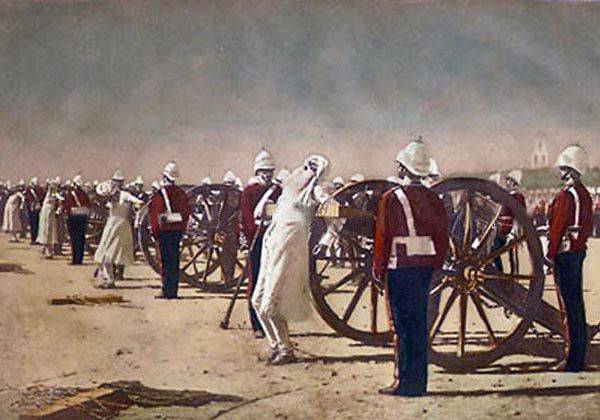
The local colonial administration built a kind of fiscal mechanism, based on the land tax. In some Indian regions, four tax systems were formed that were based on different forms of land use. At the same time, some economic measures were carried out in the country: the construction of the first railway, the organization of the postal service, the construction of the Gangetic irrigation canal. On the one hand, they carried the benefits of civilization to India, and on the other hand, the British bourgeoisie needed innovations in order to make it easier and cheaper to export Indian raw materials. The main masses of the Indian population did not derive any benefit from these benefits of civilization, which were mainly focused on the British themselves, as well as on the representatives of the native aristocracy. Along with this, the position of ordinary Indian peasants, artisans and workers deteriorated over time. These classes bore the brunt of the ever-increasing taxes, duties and taxes that went to the maintenance of the Anglo-Indian army, in which there were more than 350 thousands of people and the entire bureaucratic apparatus of the British administration.
In general, the economic policy pursued by the British in India led to the disruption of traditional ways of life, and also destroyed the beginnings of the market relations that began to take shape in India before intervention by the UK. The colonialists sought to do everything to translate the Indian economy to the needs of the industrial society of the metropolis. After the rural community was destroyed with the direct participation of the British, the process of developing new capitalist relations in the country began. At the same time, part of the local aristocracy suffered from the British innovations. In Bengal, many local ancient aristocratic families as a result of land-tax reform implemented by the British were devastated and replaced by a new layer of landowners who came to replace them from officials, urban merchants, usurers and speculators. The policy pursued by Governor-General Dalhousie, unceremoniously eliminated a number of Indian principalities. At the same time, local native princes lost their thrones, subsidies and titles, considerable damage was caused to various feudal dynasties of the country. Finally, after the annexation of Oudh in 1856, the British administration significantly curtailed the rights and possessions of the local large feudal lords, the talukdars.
The initiated transformation of the agrarian sector, which was the basis of the traditional Indian economic structure, the destruction of traditional handicraft production — the birthplace of cotton eventually ceased to export finished fabrics from local raw materials to the metropolis. Gradually, the main export of India was not finished goods, but raw materials for factories located in the metropolis. All this led to a serious aggravation of the socio-economic situation in India. The British, destroying and transforming the foundations of Indian society, were in no hurry to create new conditions that could provide the people of India with progressive cultural and economic development.
Along with this, the colonial authorities infringed upon the interests of a significant part of the Indian nobility. In the middle of the 19th century, its representatives massively took away their possessions from the pretext of “bad management”. There was also a reduction in pensions, which the British paid to many Indian princes. In the future, it is the representatives of the local princely aristocracy who will stand at the head of the sparse uprising that broke out spontaneously. In addition, the colonial British administration decided to impose taxes on land that belonged to the Indian clergy, which also did not add to its popularity. This policy caused outright irritation among the Hindu and Muslim clergy, who at that time enjoyed tremendous influence among the common people.
Along with this, the Sipai Indians, as noted above, were dissatisfied with a significant reduction in their salaries, as well as the fact that they began to be used in various military conflicts outside of India itself - in Afghanistan, Iran and China. Thus, by the middle of the 19th century, a whole set of socio-economic factors had formed in India, which had led to the uprising, and local actions against the British colonial administration took place in India throughout the first half of the 19th century.
Reason for rebellion
To start the uprising, any spark was needed, and this sparked the infamous problem with the means of caring for the new Enfield system capsules that had just been adopted. The grease of this rifle and the impregnation of cardboard cartridges for it contained animal fats, the top of the same cartridge (with a bullet) had to be bitten when the gun was loaded (gunpowder was poured into the gun barrel from the cardboard sleeve, the sleeve itself was used as a wad, from above ramrod bullet clogged). The Sipai, who were both Hindu and Muslim, were greatly frightened by the prospect of desecration through such close contact with the remains of animals — cows and pigs. The reason was characteristic and existing religious taboos: a cow for Hindus is a sacred animal, eating a great sin is its meat, while a Muslim is considered an unclean animal.
At the same time, the army leadership insisted on the use of a rifle of a new model and cartridges to it smeared with forbidden animal fats, ignoring the discontent growing among the sipahs. When this error was still fully realized, it was already too late. Many sipai interpreted British innovations as deliberately insulting their religious feelings. And although the command had previously ensured that the Sipai units were staffed on a mixed religious basis in order to eliminate the possibility of collusion among them, the effect in this case was completely opposite. Both the Hindu and Muslim sipahus forgot their differences and joined together to defend the "Dharma and the Koran."
Rise of the sepoys
The uprising began on May 10 of 1857 in Meerut. The beginning of the uprising was the refusal of the 85 sepoys to conduct training firing with new cartridges containing animal fat. For this, they were sentenced to death, which they replaced 10 for years with hard labor. The convicts were sent to prison, but the very next day, an uprising of three Bengali regiments began in Meerut, which was located 60 kilometers from Delhi. Subsequently, the uprising, like a forest fire, spread to the whole Bengali army. On the day of the beginning of the uprising, many British soldiers were in dismissal, they had a day off, so they could not provide organized resistance to the rebel natives. The rebels killed a number of British soldiers and officers, as well as civilian officials and Europeans, including women and children. They also released 85 prisoners sentenced to penal servants and more about 800 prisoners from the local prison.
Quickly enough, the rebels captured Delhi, where a small detachment of English officers from 9, realizing that they could not defend the local arsenal, simply blew it up. At the same time, 6 survived, but as a result of the explosion, many people died on the streets and nearby houses were destroyed. The insurgent sepoys expected to raise the whole of India, so they went to the palace, in which the last descendant of the Great Moguls, the Padishah of Bahadur Shah II, lived his life. 11 May 1857, the rebels entered Delhi, and the very next day the padishah accepted the help of the sepoys and declared his support for the uprising, calling on all Indian people to fight for independence. What began as a small uprising quickly turned into a real war of liberation, the front of which stretched from Punjab to Bengal, and Delhi, Kanpur and Lucknow, where their own governments were formed, became the main resistance center in India. The British had to retreat to the south of India, where relative calm was maintained and military units loyal to the East India Company were located.
Having recovered from the first sudden strike, the colonial forces began to suppress the uprising. The British knew perfectly well that Delhi became the hustler of the sipahs, so the first strike was sent to that city already on 6 on June 1857. First, General Harry Barnard managed to capture the Bedliko-Serai range, which dominated Delhi, and then began to besiege the city, which lasted for 4 months. The British managed to prepare the Indians well, turning them into excellent fighters. Especially distinguished were the gunners, who, in the skill of shooting, surpassed the colonialists themselves. Army General Barnard, most likely, would have been very tight, if Delhi had not been blown up by the same local arsenal. His explosion left the insurgent sipahis in the city practically without shells. But even in spite of this, the Delhi 30-thousandth garrison tried to make regular attacks from the city, attacking the enemy and destroying small British troops.
During the siege, reinforcements from new British soldiers came to the aid of the colonists (part of the troops were transferred from Singapore and the metropolis, part after the end of the Crimean War approached by land through Persia), as well as Hindus, who were loyal to the colonial administration. They were mainly Sikhs and Pashtuns of Pendjba. 7 September 1857, the British received powerful siege weapons and began artillery preparation, during which they were able to make gaps in the walls of the city. September 14 colonial troops went to the storming of the city as part of four columns. At the cost of serious losses, they managed to seize a bridgehead directly in Delhi, followed by bloody street battles that lasted a week and ended with the fall of the city.
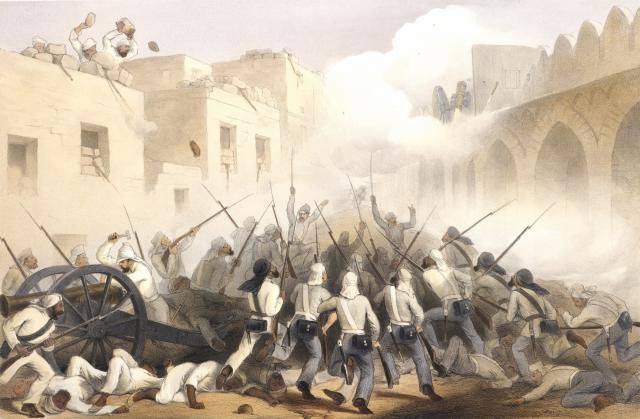
The British, who had lost their soldiers during the 1574 assault, were literally frantic with rage. From the cannons they shot the main city mosque, as well as the buildings adjacent to it, in which the elite of the Muslim population of India lived. Delhi was robbed and destroyed, many civilians were simply dragged out of their homes and killed in revenge for their comrades who died in battle. Having broken into the palace of the padishah, the victors captured Bahadur Shah II, and his entire family was shot. So along with Delhi fell the ancient Mughal dynasty. After the capture of Delhi, the British methodically suppressed an uprising in other cities. 16 March 1858 captured Lucknow by them, and on June 19, in the battle of Gwalior, the troops commanded by General Rose defeated the last major rebel detachment led by Tatia Tony. After that, they eliminated only small pockets of resistance. The main reasons for the defeat of the uprising were the best equipment of the English colonialists, the differences in the goals of the rebels, especially the poor peasants and artisans and the rich feudal lords, the division of peoples that remained in India, which allowed the British to isolate the main centers of the uprising.
The outcome of the uprising
The uprising of the sepoys was finally crushed by April 1859. Despite the fact that the uprising ended in defeat, the British colonialists were forced to change their policies in India. On November 1, 1858 in India was promulgated by the manifesto of Queen Victoria, who announced the transfer of the administration of India to the English crown and the liquidation of the East India Company. Queen Victoria promised her forgiveness to all the Indian feudal lords who joined the Sepoy uprising, excluding those who were directly involved in the murder of British citizens. After the adoption of the India Governance Act, the East India Company lost its original meaning, although it was able to exist even before 1873, but already as an ordinary commercial organization. A number of laws were also passed, which secured the ownership of land for Indian feudal lords, and thanks to rental laws that limited the arbitrariness of princes and landlords, the colonists managed to reduce the degree of discontent among Indian peasants.
After the East India Company was removed from power in India, its armed forces (European and Singaporean) were turned to the troops of the royal service. At the same time, the old Sipai army almost ceased to exist. In the Bengal army, the overwhelming number of sepoys sided with the 1857-1859 uprising. During the reorganization of this army in it, first of all, the number of Englishmen was increased. Before the uprising, there were five sepoys for each English soldier, and after the uprising the ratio was reduced to one to three. At the same time, the artillery and technical units were now staffed only from the British. The number of English non-commissioned officers and officers has also increased in the Sipai units.
The national composition of the updated sub-parts was also changed. The Brahmins stopped recruiting for military service, the recruitment of the inhabitants of Oud and Bengal was stopped. The Muslim tribes of the Punjab, the Sikhs and the warlike inhabitants of Nepal (Gurkas) made up the majority of the newly recruited soldiers of the Anglo-Indian army. Now, in most cases, a third of each regiment were Hindus, a third - Muslims, a third - Sikhs. Moreover, they all belonged to different nationalities of India, spoke different languages and professed different religions. Making extensive use of religious and national division, while recruiting the most backward tribes and nationalities of India (with the exception of Sikhs), the British hoped to prevent the bloody events of 1857-1859.
Information sources:
http://orientbgu.narod.ru/seminarnov/sipay.htm
http://www.e-reading.mobi/chapter.php/1033674/13/Shirokorad_-_Britanskaya_imperiya.html
http://warspot.ru/459-vosstanie-sipaev
http://army.lv/ru/sipayskoe-vosstanie/2141/3947
Open source materials
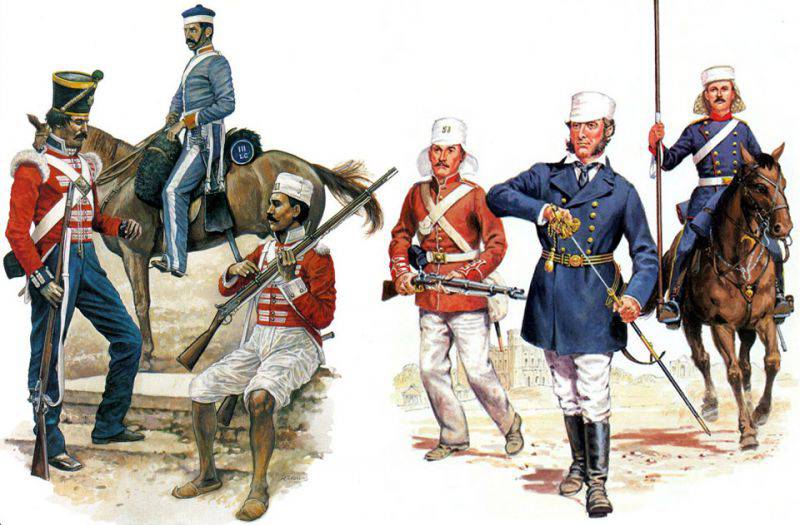
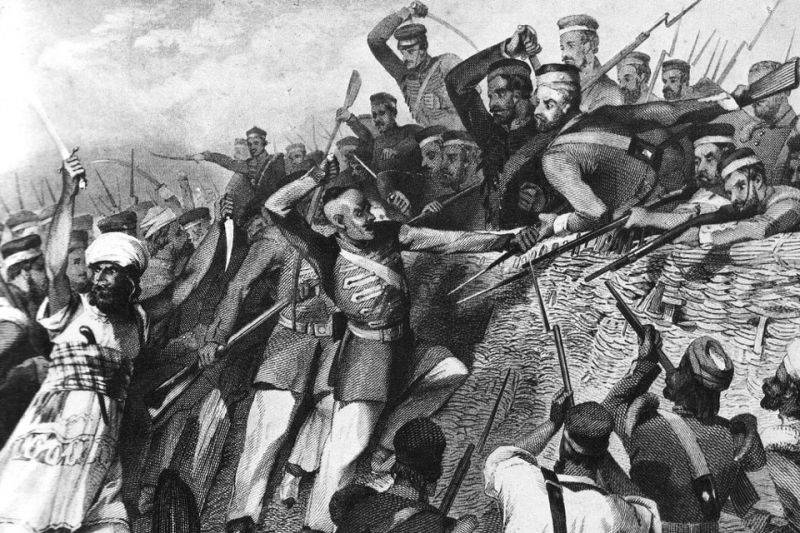
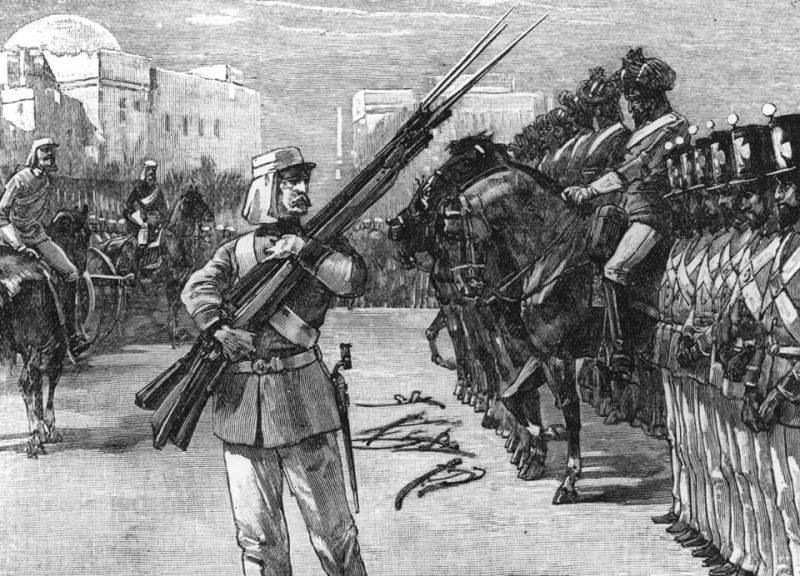
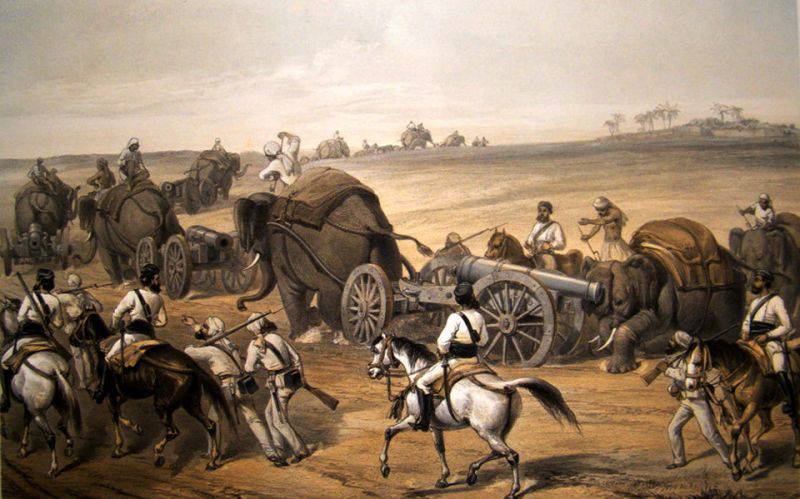
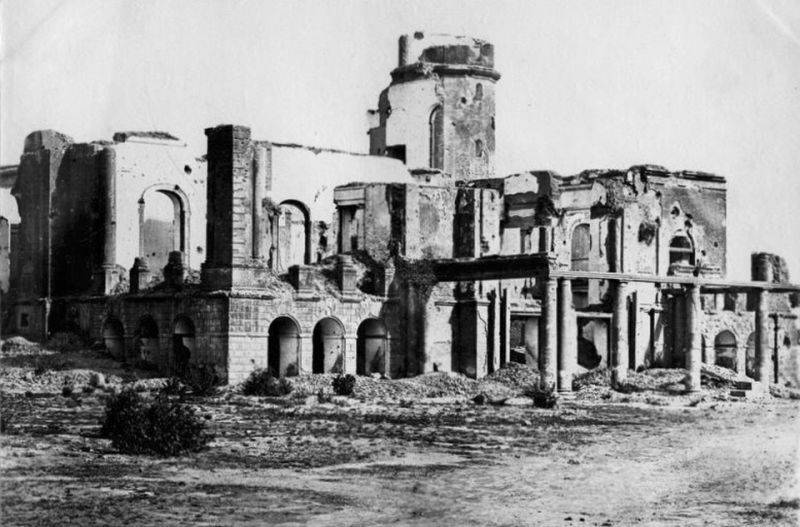
Information